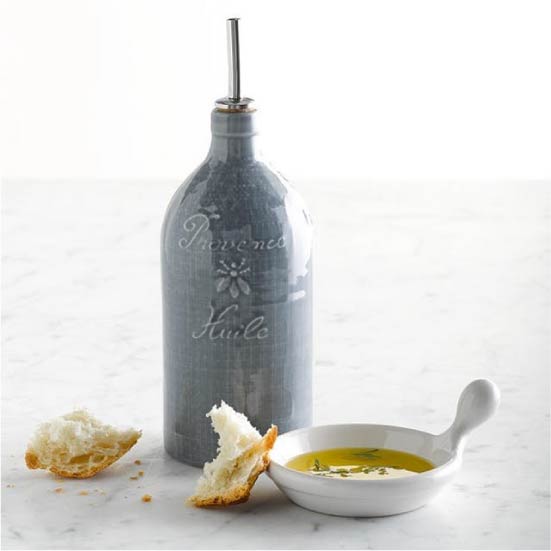All types of oils, from olive to coconut and cream, have only 4 enemies:
- Shine;
- Heat;
- Oxygen;
- Sharp temperature drops.
Under their influence, the oil is oxidized, becomes rancid, loses its taste, aroma and beneficial properties. The best way to prevent this (and even extend the shelf life of the product) is proper storage. Today we will talk about home storage of 5 of the most favorite types of oils:
- olive;
- sunflower;
- flaxseed;
- coconut;
- creamy.
How to store vegetable oils (olive, linseed, sunflower)
In the issue of storage of oils there are three things that should be considered: Where keep it as keep it and in what.
Temperature conditions
Before opening: Let's start with the good news - most vegetable oils can be stored at room temperature, that is, at + 20-24 ° C, but no more. The minimum allowable temperature is 5 ° C. Well, the optimum mode is about 14 ° C. Such an ideal climate at home can only provide a wine cooler.
After opening: and here is not very good news - unfortunately, most vegetable oils (olive, sunflower, linseed) need to be consumed within 1 month after opening the bottle. After a month, the oil remains suitable for consumption, but still it is undesirable to use it in food, since toxic and even carcinogenic substances are formed in the product. The taste of the oil one month after opening the packaging becomes bitter (especially in olive and linseed oil), the flavor is neutral.
- One month after opening, olive oil can be used as sunflower oil - for frying.
- After opening, it is advisable to store flaxseed oil in the refrigerator on the middle / upper shelf or in the fruit and vegetable compartment.

Flaxseed oil after opening stored in the refrigerator
- Because of the rapid rancid, buying large jars of olive, linseed and unrefined sunflower oil is not very reasonable. It is better to buy a product less, but more often.
Where to store
So, all oils like dark, dry and cool (but not cold!) Places. Where to find them in the kitchen of a city apartment?
The optimal solution for both long-term and daily storage of oils is a closed cabinet, preferably a lower one (after all, it is lower, the cooler) and not too close to the stove. It is not recommended to store spices near the oil, as it tends to absorb odors.


Unfortunately, the most convenient place to store oil is the tabletop, which is the most unfavorable because of its proximity to the stove, daylight and artificial light, and temperature drops. But it's so convenient to always have a bottle on hand, what to do? A compromise is possible: just pour the oil from a large bottle into a small one for a week or two. The bottle should be dark glass and stand away from the plate.

An ideal place for long-term storage of oils is the wine cellar or its modern substitute - a wine cabinet-fridge with a 14-degree temperature. Can I store oil in a regular fridge? Yes you can, but carefully.
- Firstly, the oil extracted from the refrigerator cannot be kept warm for a long time, it must be kept in the cabinet, then again in the refrigerator. Remember, an abrupt change of climate is one of the enemies of any butter.
- Secondly, it is advisable to store the oil in the refrigerator in the compartment for fruits and vegetables (the temperature is set at about 8 degrees) or on the top shelf (7 degrees heat). Do not forget that too low temperatures (below 5 degrees), which are characteristic of the middle and lower shelves of the refrigerator, are harmful to oils. But the refrigerator door is not the best option, as the climate on the door shelves, although optimal for storing oils, is too unstable.

By the way, there is another nuance that applies only to olive oil: when it is stored in the refrigerator, white flakes form in it. To be afraid of this is not necessary, on the contrary, such a sediment only proves that the purchased oil is truly olive. At room temperature, it will regain its normal consistency.
What to store oil
Ideal dishes - from dark glass (for example, amber or cobalt) with a tight lid and, possibly, with a dispenser or spray.

Also a good ceramic vessel that can be tightly closed.

But metal containers (for example, those in which oil is often sold) are less suitable. As a rule, oil of average quality is sold in such packages.

The worst choice of oil storage containers is plastic bottles. If you bought fresh and valuable oil (olive, linseed, unrefined or raw sunflower) in such a package, say, on the market, then it should be poured into a bottle of dark glass. In general, it is better to refuse to buy oil in plastic packaging, since during storage, chemical compounds that are harmful to health can be transferred from plastic to the product. The only oil that can be sold in plastic packaging is refined sunflower and coconut.
- If you bought the oil in a transparent glass bottle, then it can be wrapped in foil.
See also: How to store vegetables and greens
How to store coconut oil
Temperature and storage locations
Coconut oil is one of the most unsightly oils: you can store it for a long time, it is not too afraid of heat (more than 24 degrees) and even light. But there is one important nuance - the consistency of coconut oil depends on the storage temperature.

Liquid consistency coconut oil is the most convenient to use for both culinary and cosmetic purposes.
At room temperature, it becomes liquid - and this is the most convenient option for consuming the oil for food and for carrying out cosmetic procedures. At temperatures below 20 degrees, coconut oil will acquire a jelly-like consistency, and in the refrigerator it will harden.

It turns out that the product that you use often or daily is best stored just on a shelf in the closet and even on the tabletop.
However, for long-term storage of coconut oil (especially unrefined), which you use only occasionally, the upper shelf of the refrigerator or the compartment for fruits and vegetables will be more suitable.
- Refined coconut oil can be stored in the refrigerator for up to 1 year, and unrefined - up to six months.
- For easier use when storing in the refrigerator, coconut oil can be poured into silicone ice molds as shown in the photo below.

But the bathroom is suitable for storing coconut oil less due to high humidity.
What to store
As for the container for storing coconut oil, a dark glass jar with a tight lid is best, but opaque plastic will also fit.
How to store butter
Temperature and storage locations
The optimum temperature for storing butter daily use - from 0 to 6 degrees. This is exactly the climate that a refrigerator can provide; here the oil can be stored for 15 days after opening.
- In order for butter not to be too hard and easily spread on bread, it should be stored on the top shelf of the refrigerator, in the fruit and vegetable compartment or on the door shelf.
But for long-term storage (up to 1 year) you need to use the freezer. But still this option is not the best, since during long-term storage in the cold, butter becomes less tasty and healthy.
Remember that for a long time to leave the butter at room temperature is impossible. Due to exposure to heat and light, it will become yellow, oxidize, lose its beneficial properties and taste.
However, if there is no refrigerator nearby, for example, in field conditions or a country house, then you can save the oil in one of the following ways:
Method 1. Wrap the oil in a cotton cloth soaked in a solution of water and vinegar. When the fabric dries, moisten it again with the solution.
Method 2 Put a piece of oil in a jar and pour vinegar so that it covers the bar a couple of centimeters.
Method 3. Wrap a bar of oil up to 200 g (or several bars) in parchment, then place it in a deep container and cover it with a strong solution of salt. Keep the oil container in a dark place and change the brine daily.
What to store
Butter can be stored both in a butter dish and in factory foil packaging. Also suitable parchment paper (pictured below) or foil. The main thing is that the package or container protects the oil from light.

You should not store the butter in plastic containers and plastic bags - in such containers the product will quickly go rancid, turn yellow and spoil.
- 12 tips on how to keep food fresh longer and stop throwing them out
- How to store fruit at home - general principles, a memo and photo ideas
- 8 questions and answers about storing honey
- Storage in the kitchen - 17 super-efficient solutions and life hacking
- What should be the temperature in the refrigerator?



 (Rate the material! Already voted:5 average rating: 4,20 from 5)
(Rate the material! Already voted:5 average rating: 4,20 from 5)